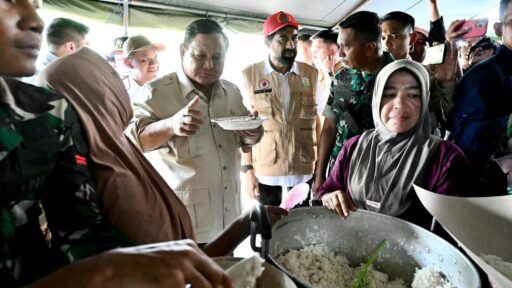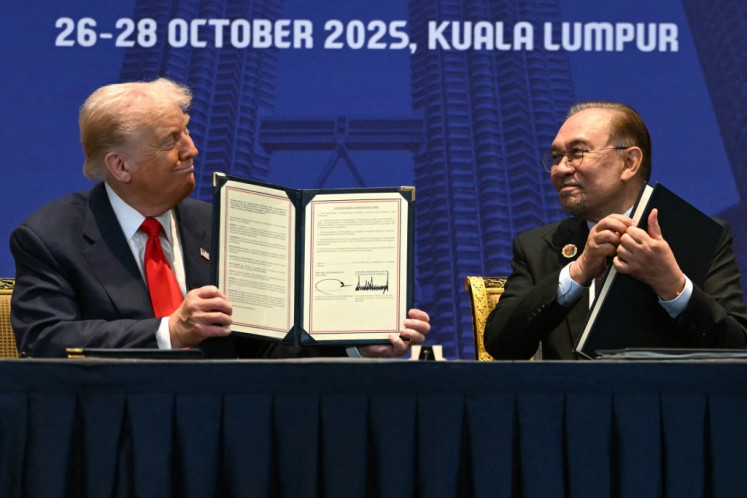Popular Reads
Top Results
Can't find what you're looking for?
View all search resultsPopular Reads
Top Results
Can't find what you're looking for?
View all search resultsSaving a rainforest after the flood
Rushing water: The Bohorok River runs through the town of Bukit Lawang
Change text size
Gift Premium Articles
to Anyone
 Rushing water:: The Bohorok River runs through the town of Bukit Lawang. (Hannah Maddison-Harris)" border="0" height="383" width="510">Rushing water: The Bohorok River runs through the town of Bukit Lawang. (Hannah Maddison-Harris)
Rushing water:: The Bohorok River runs through the town of Bukit Lawang. (Hannah Maddison-Harris)" border="0" height="383" width="510">Rushing water: The Bohorok River runs through the town of Bukit Lawang. (Hannah Maddison-Harris)Bukit Lawang â the âgateway to the hillsâ â is the last stop along North Sumatraâs winding Bohorok River before the rainforest begins.
The mind-set of people here is notably different from those in other parts of the province that have been cleared for oil-palm cultivation.
Flanked by plantations, residents of the town, situated some 70 kilometers from Medan, are preserving their patch of rainforest through ecotourism centered on the areaâs orangutans.
Gunung Leuser National Park (TNGL) was founded in 1980 and named a UNESCO Biosphere Reserve in 1981.
 Rushing water: <)
Rushing water: <)
Rushing water: The Bohorok River runs through the town of Bukit Lawang. (Hannah Maddison-Harris)
Bukit Lawang ' the 'gateway to the hills' ' is the last stop along North Sumatra's winding Bohorok River before the rainforest begins.
The mind-set of people here is notably different from those in other parts of the province that have been cleared for oil-palm cultivation.
Flanked by plantations, residents of the town, situated some 70 kilometers from Medan, are preserving their patch of rainforest through ecotourism centered on the area's orangutans.
Gunung Leuser National Park (TNGL) was founded in 1980 and named a UNESCO Biosphere Reserve in 1981.
Forest people: For lucky visitors, semi-wild Sumatran orangutans can be seen within a few hours' trek of Bukit Lawang. (Hannah Maddison-Harris )
The park, home to some of Sumatra's 6,600 remaining orangutans, is part of the Leuser Ecosystem that straddles Aceh and North Sumatra.
It is the only place in the world where critically endangered Sumatran orangutans, tigers, elephants and rhinoceros still live together.
'About 30 percent of the Sumatran [orangutan] population lives inside the TNGL and the remaining majority of the population lives in lowland forests of the Leuser Ecosystem,' says the Medan-based Orangutan Information Center's (OIC) founding director, Panut Hadisiswoyo.
'Sustainable ecotourism in Bukit Lawang not only provides economic opportunities for local people, but also contributes to the protection and conservation of Leuser forests and their biodiversity,' Panut said.
Most tours from Bukit Lawang are coordinated by the tour-guide association Himpunan Pariwisata Indonesia (HPI), which provides guide training. The HPI works with park rangers and can assist in emergencies.
Guide Monang Ricky Tarigan, 21, said that he has been taking visitors into the forest to see orangutans for the past seven years.
Monang says local residents 'are not strong enough' to protect the forest alone. Tourism provides the money that is needed to help, meaning 'there are more jobs' and 'the jungle can be more safe'.
While many tourists opt for one- or two-day treks, guides sometimes support longer research trips, as further afield the park is home to protected plants such as the Rafflesia and Amorphophallus as well as its array of animals.
There is an art to leading groups in search of the orangutans, gibbons and other monkeys that live within a day's walk of the town.
Fellow HPI member Wisnu Wardana, 24, estimates he has led around 1,000 treks in his past five years as a guide.
While practice may help, the skills also seem to run in their veins ' both Monang's uncle and Wisnu's father were part of the team that mapped the first trails in the TNGL when it was established.
According to Wisnu, the park has designated locations for camping to limit the space affected by visitors, group sizes are capped and separate teams regularly trek through to remove items inadvertently left behind.
Remarkably, these initiatives, as well as facilities in the town, are the fruits of rebuilding.
In November 2003, a flash flood devasted Bukit Lawang.
In darkness, within about 15 minutes, all structures on low ground were swept away. According to local residents, over 200 people perished, as did a small number of foreigners.
Over a decade later, people in Bukit Lawang regularly monitor the Bohorok River and clear debris that might trigger flooding.
While opinions vary on the cause of the flood, conservationists point to logging and land degradation.
Plantation crops in the area include rubber, cacao and coffee.
However, with some rubber farmers making as little as Rp 200,000 a month, and crops like cacao taking up to six years to provide a profit; many resort to more lucrative options, such as oil-palm plantations.
Some residents disagree. 'Palm oil is not good for the jungle, and not good for the earth,' says Monang. 'It's short-term thinking, to get an income.'
However, in Bukit Lawang, improved livelihoods are a run-on effect of tourist dollars, with some guides setting up small-scale fish farms or vegetable plots and other residents also benefiting.
Restaurant owner Siti Rukayah said that following the flood, the government provided residents with free new housing on higher ground.
However, as it was an hour's walk from Bukit Lawang, she decided after a year to move back to the river to better access tourists.
The mother of three now sells wooden jungle carvings and offers cooking classes that are popular during high season.
The OIC has worked with both residents and park authorities since 2007 on several community initiatives, such as a restoration program in Sei Betung inside the TNGL, where 500 hectares of protected forests were illegally converted to oil-palm plantations.
'At this site, Sumatran orangutans, elephants, sun bears, and many other species of animals and birds have returned, indicating successful ecosystem restoration,' Panut says.
The OIC has also replanted degraded national-park land with almost one million seedlings. 'This work has been carried out with the full support of the local community, which helps safeguard the area from future encroachment,' Panut says.
Meanwhile, ecotourism in Bukit Lawang continues to evolve. For example, a former feeding platform for rehabilitated orangutans has closed, as the animals have transitioned to a semi-wild existence.
In general, local residents and NGOs work with limited government support.
Some say a recent increase in park entrance fees reflects exploitation of the popular site, claiming that the extra revenue should more directly bolster conversation efforts.
Poor enforcement of laws prohibiting development that might degrade the Leuser Ecosystem is a problem, Panut says.
'Despite being protected under Indonesian law, the [ecosystem] is still subject to high levels of illegal encroachment.'
Bukit Lawang is driven by a simple idea: If it provides ecotourism successfully, people can earn a living by working with the forest, instead of against it.










